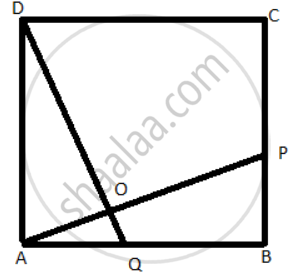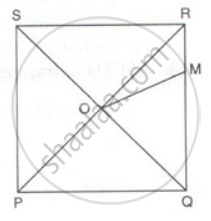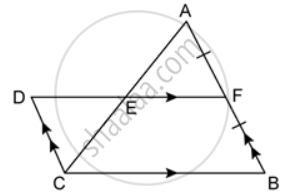Advertisements
Advertisements
Question
ABCD is a square. A is joined to a point P on BC and D is joined to a point Q on AB. If AP = DQ;
prove that AP and DQ are perpendicular to each other.
Solution

ABCD is a square and AP = PQ
Consider ΔDAQ and ΔABP,
∠DAQ = ∠ABP = 90°
DQ = AP
AD = AB
ΔDAQ ≅ ΔABP
⇒ ∠PAB = ∠QDA
Now,
∠PAB + ∠APB = 90°
also ∠QDA + ∠APB = 90° ...[∠PAB = ∠QDA]
Consider ΔAOQ by ASP
∠QDA + ∠APB + ∠AOD = 180°
⇒ 90° + ∠AOD = 180°
⇒ ∠AOD = 90°
Hence, AP and DQ are perpendicular.
APPEARS IN
RELATED QUESTIONS
All squares are rhombuses and also rectangles.
Identify all the quadrilaterals that have four right angles
Explain how a square is a rhombus.
In a quadrilateral ABCD, AB = AD and CB = CD.
Prove that:
- AC bisects angle BAD.
- AC is the perpendicular bisector of BD.
In square PQRS :
(i) if PQ = 3x – 7 and QR = x + 3 ; find PS
(ii) if PR = 5x and QS = 9x – 8. Find QS
PQRS is a square whose diagonals PR and QS intersect at O.M is a point on QR such that OQ = MQ. Find the measures of ∠MOR and ∠QSR.
Prove that the quadrilateral formed by joining the mid-points of a square is also a square.
In the given figure AF = BF and DCBF is a parallelogram. If the area of ΔABC is 30 square units, find the area of the parallelogram DCBF.
In a parallelogram PQRS, M and N are the midpoints of the sides PQ and PS respectively. If area of ΔPMN is 20 square units, find the area of the parallelogram PQRS.
In a parallelogram PQRS, T is any point on the diagonal PR. If the area of ΔPTQ is 18 square units find the area of ΔPTS.
